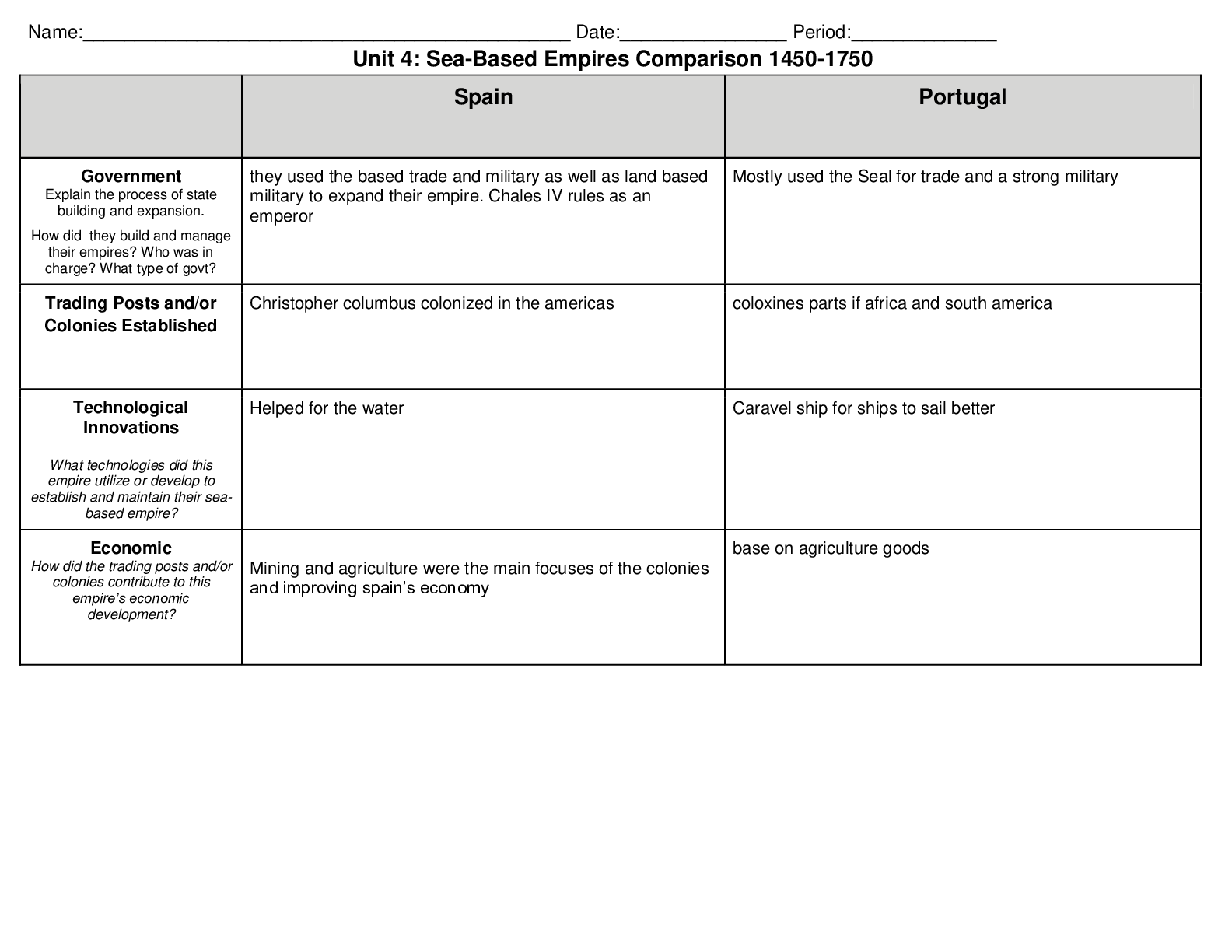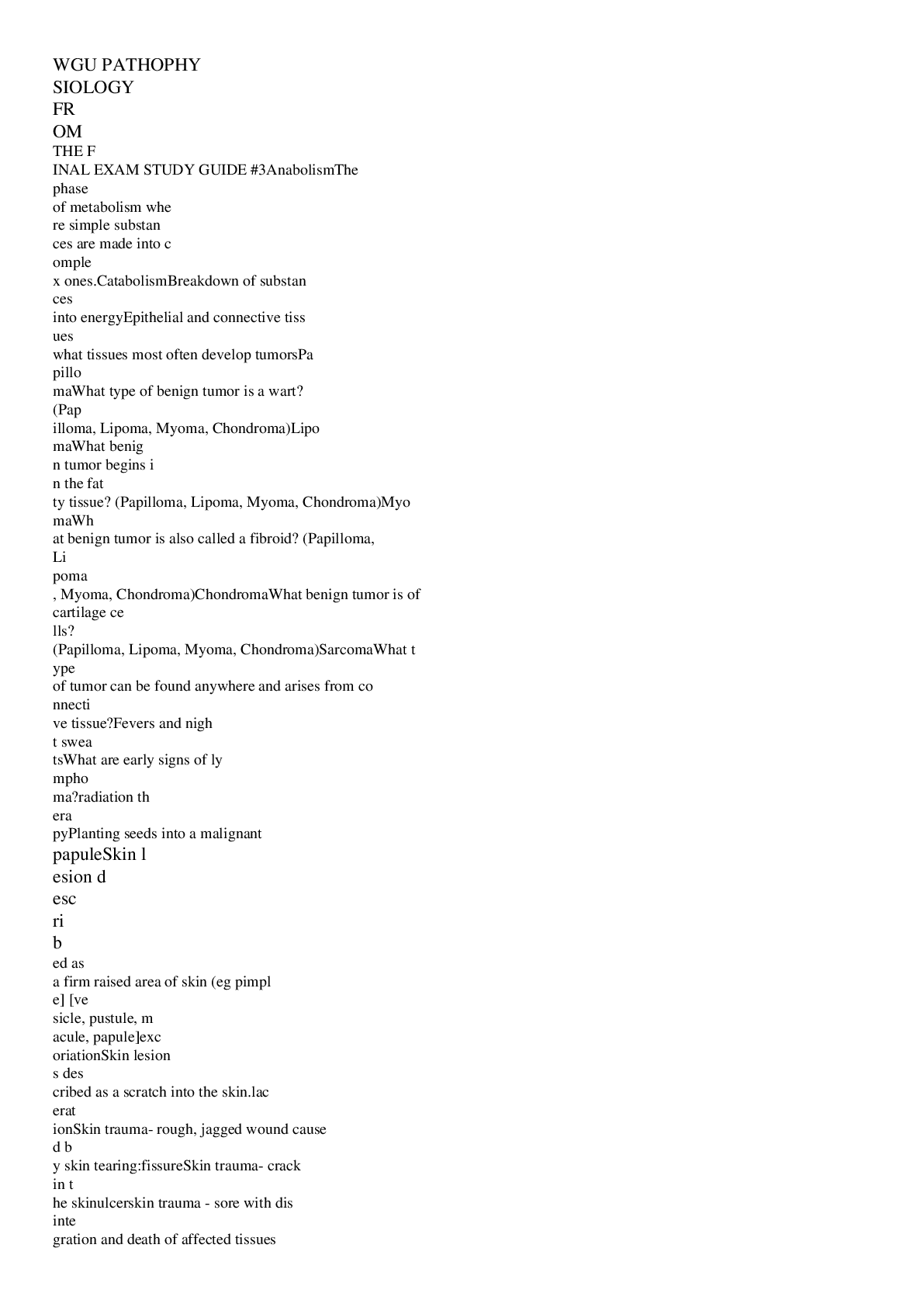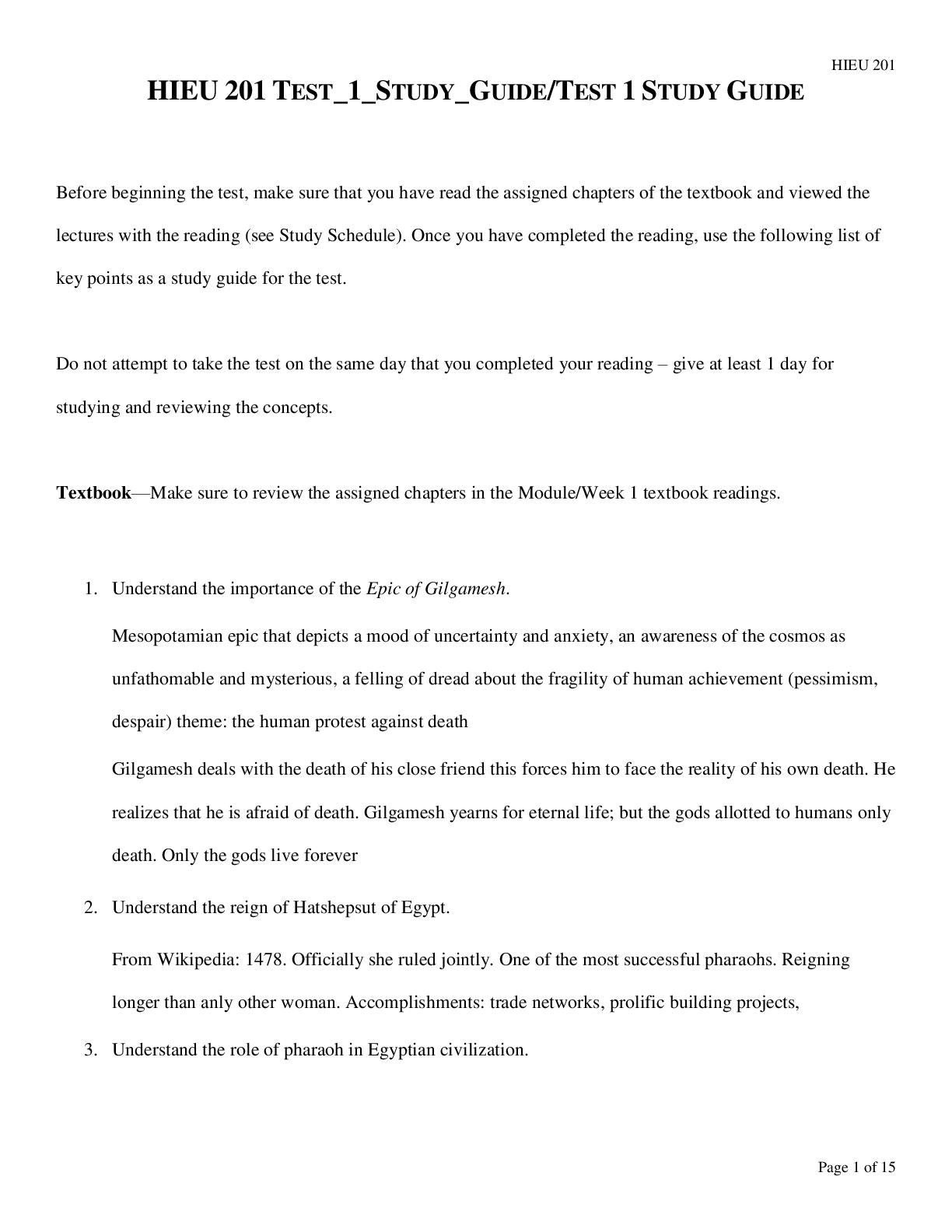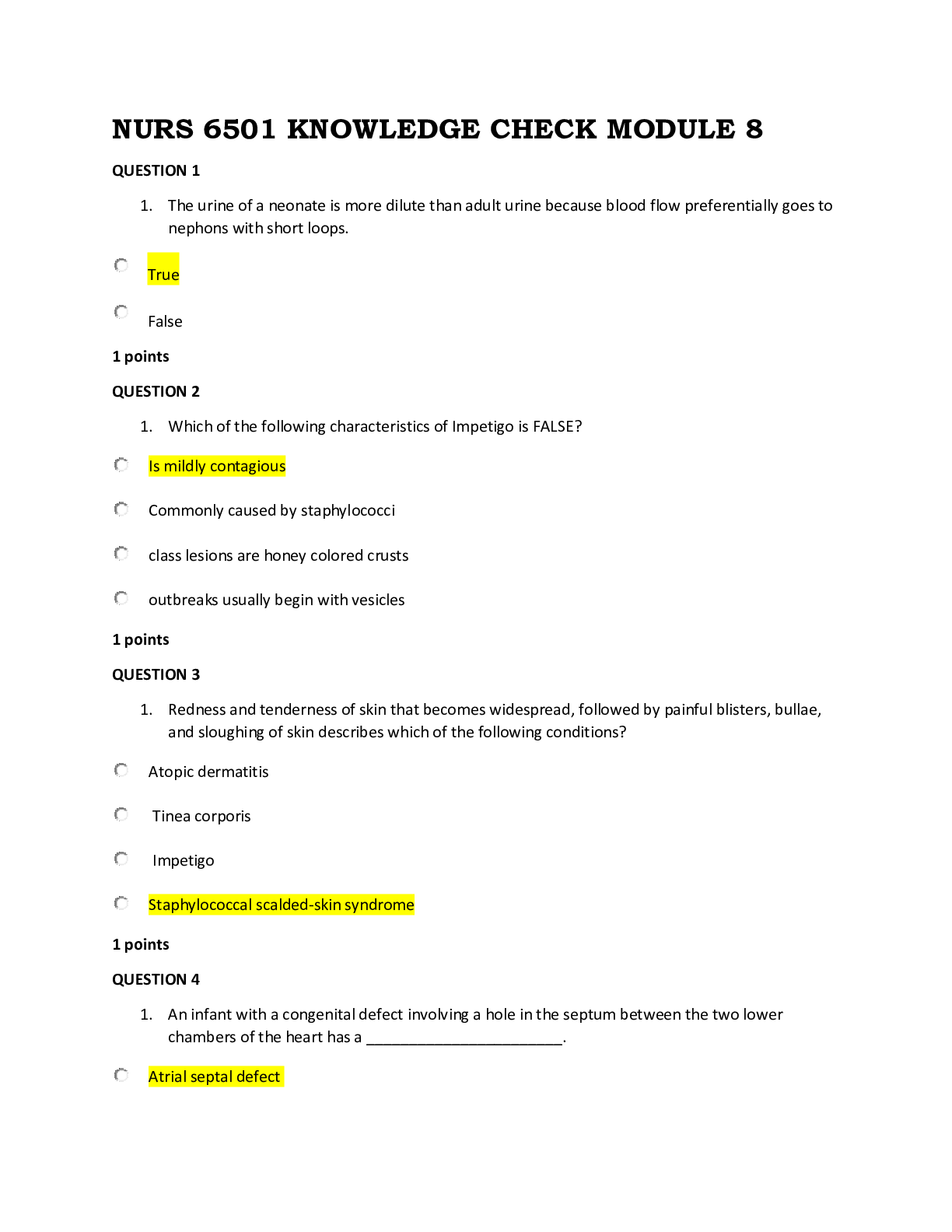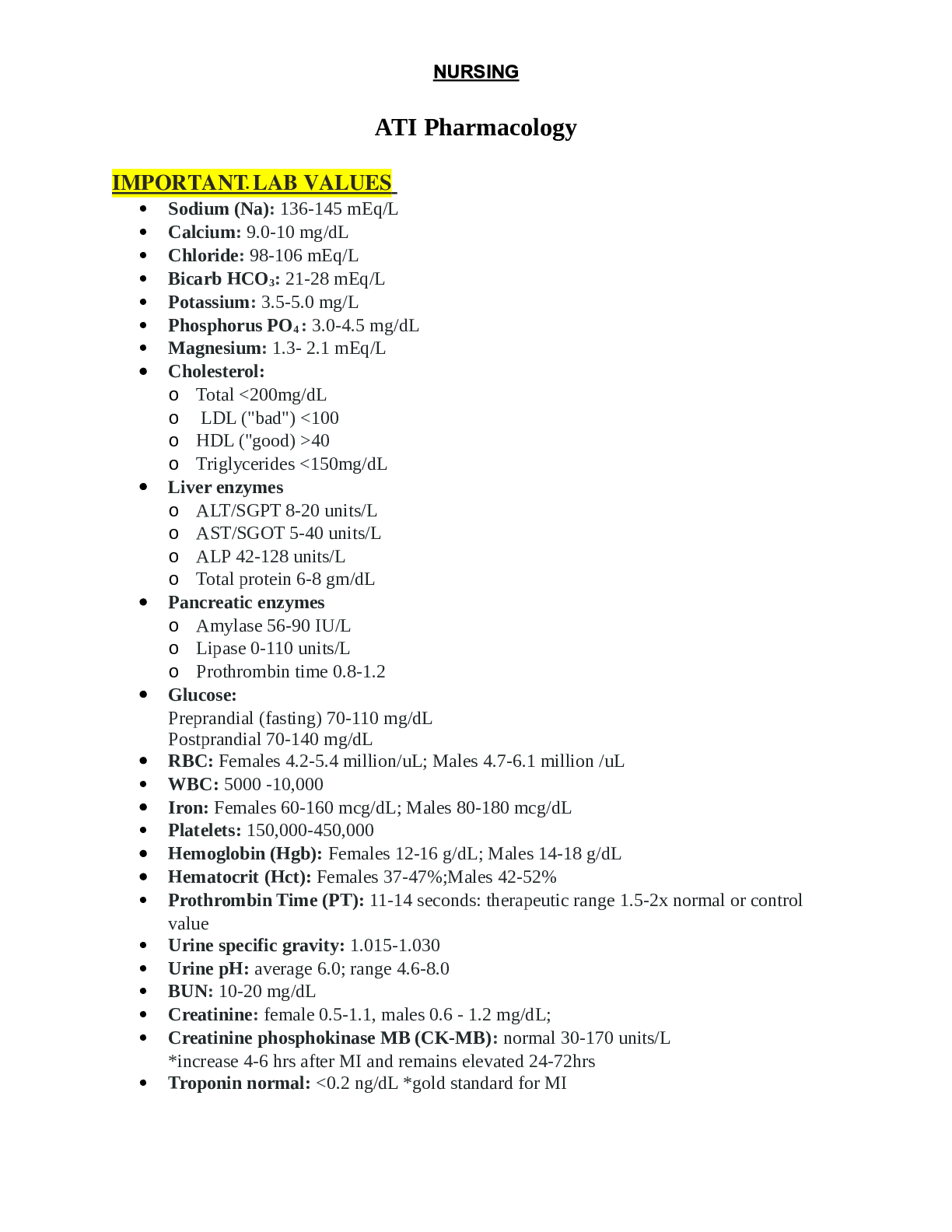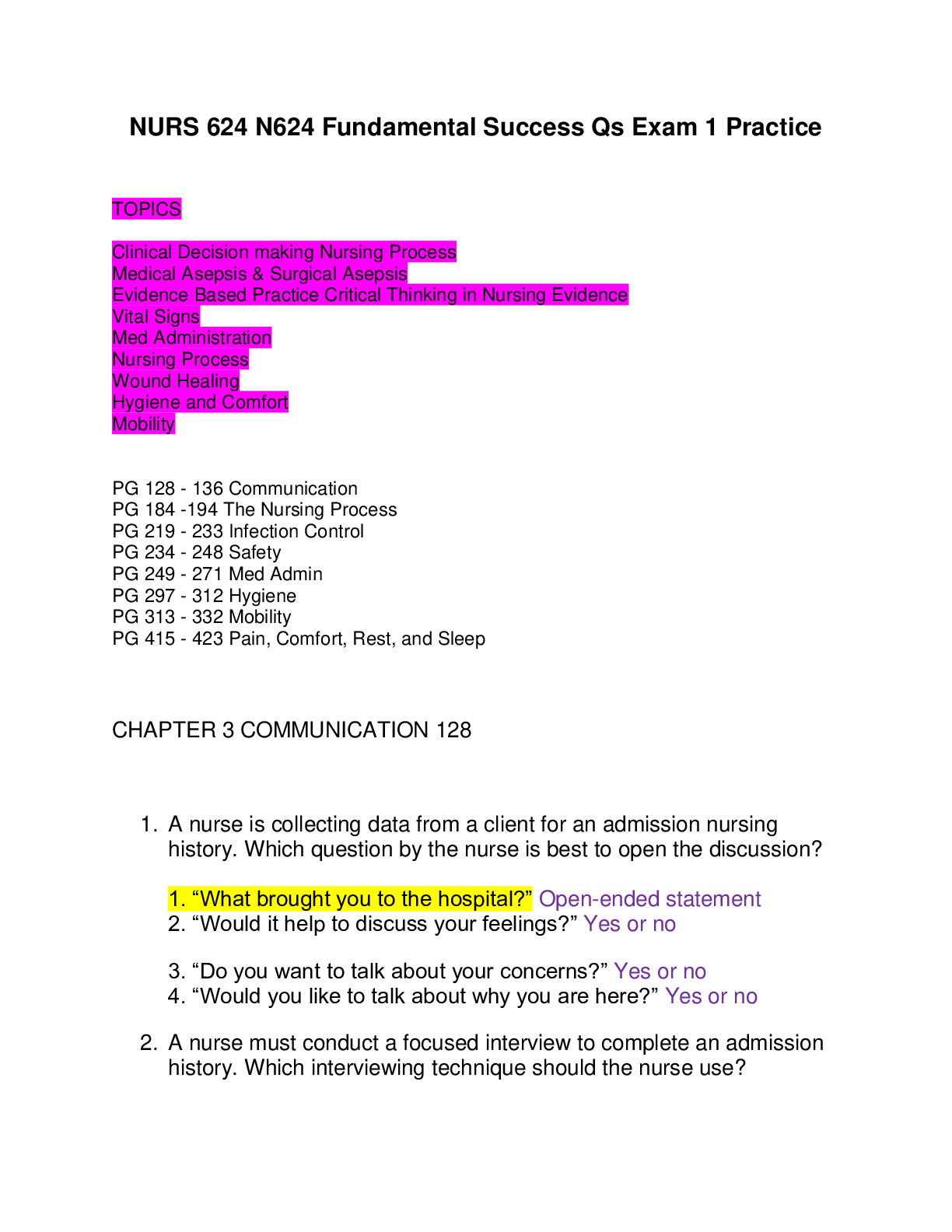*NURSING > STUDY GUIDE > NR327 - Quiz 4 - Postpartum NCLEX-Style Questions (All)
NR327 - Quiz 4 - Postpartum NCLEX-Style Questions
Document Content and Description Below
NR327 - Quiz 4 - Postpartum NCLEX-Style Questions (For Quiz 4) Source Of Questions For This Quiz: Saunders Comprehensive Review - NCLEX-RN Exam Topics For This Quiz: Postpartum Physiologic Adaptat... ions Postpartum Psychosocial Adaptations Postpartum Complications Assessment of the Normal Newborn Care of the Normal Newborn Postpartum Physiological/Psychosocial Adaptations & Postpartum Complications NCLEX-Style Questions (For Quiz 4): 1. A nurse is performing a fundal assessment for a client who is 2 days postpartum and observes the perineal pad for lochia. she notes the pad to be saturated approximately 12 cm with lochia that is bright red and contains small clots. Which of the following findings should the nurse document? A. Moderate lochia rubra B. Excessive blood loss C. Light lochia rubra D. Scant lochia serosa Rationale: A. CORRECT: The client has moderate lochia rubra containing small clots, which is an expected finding for the second day postpartum. B. Excessive blood loss is saturation of a perineal pad in 15 min or less or pooling of blood under the client's buttocks. C. Light lochia rubra is a perineal pad that is saturated less than 10 cm with lochia. D. Scant lochia serosa (less than 2.5 cm on perineal pad) is pinkish brown in color and serosanguineous in consistency. it occurs on day 4 to 12 following delivery." 2. During ambulation to the bathroom, a postpartum client experiences a gush of dark red blood that soon stops. on assessment, a nurse finds the uterus to be firm, midline, and at the level of the umbilicus. Which of the following findings should the nurse interpret this data as being? a. Evidence of a possible vaginal hematoma B. an indication of a cervical or perineal laceration c. a normal postural discharge of lochia d. abnormally excessive lochia rubra flowRationale: A. A client who has a vaginal hematoma is expected to report excessive pain or vaginal pressure. B. Excessive spurting of bright red blood from the vagina indicates a possible cervical or perineal laceration. C. CORRECT: lochia typically trickles from the vaginal opening but flows more steadily during uterine contractions. massaging the uterus or ambulation can result in a gush of lochia with the expression of clots and dark blood that has been pooled in the vagina, but it should soon decrease back to a trickle of bright red lochia in the early puerperium. D. Excessive blood loss consists of one pad saturated in 15 min or less or the pooling of blood under the buttocks, which is not affected by the client's postural changes." 3. A nurse is completing postpartum discharge teaching to a client who had no immunity to varicella and was given varicella vaccine. Which of the following statements by the client indicates understanding of the teaching? A. "i will need to use contraception for 3 months before considering pregnancy." B. "i need a second vaccination at my postpartum visit." C. "i was given the vaccine because my baby is o-positive." D. "i will be tested in 3 months to see if i have developed immunity." Rationale: A. A client is instructed to not get pregnant for 1 month following administration of varicella vaccine. B. CORRECT: A second varicella immunization is needed at 4 to 8 weeks following delivery by clients who had no history of immunity. C. Rho(d) immune globulin is administered to a Rh-Negative mother who has an rh-positive newborn. D. A client requires testing for immunity at 3 months following administration of rubella vaccine and rho(d) immune globulin." 4. a nurse is assessing a postpartum client for fundal height, location, and consistency. the fundus is noted to be displaced laterally to the right, and there is uterine atony. the nurse should identify which of the following conditions as the cause of the uterine atony? a. Poor involution B. urinary retention c. hemorrhage d. infection Rationale: B "a. Poor involution is the result of uterine atony and does not cause it. B. CORRECT: urinary retention can result in a distention of the bladder. a distended bladder can cause uterine atony and lateral displacement from the midline, usually to the right. c. hemorrhage is the result of uterineatony and does not cause it. d. infection does not cause uterine displacement or atony and would be characterized by foul-smelling vaginal discharge and elevated temperature." 5. a nurse is caring for a client who is 1 hr postpartum following a vaginal birth and experiencing uncontrollable shaking. the nurse should understand that the shaking is due to which of the following factors? (select all that apply.) a. change in body fluids B. metabolic effort of labor c. diaphoresis d. decrease in body temperature E. decrease in prolactin levels Rationale: A B "a. CORRECT: a shift in body fluids during the first 2 hr puerperium can cause a postpartum chill. B. CORRECT: the work of labor can cause a postpartum chill during the first 2 hr puerperium. c. diaphoresis is the mechanism by which the excess fluid of pregnancy is removed from the body. it usually occurs within the first 2 to 3 days following delivery. d. an increase in body temperature is associated with a postpartum chill, but it is not the cause of it. E. changes in prolactin levels affect ovulation and menses and are not the cause of a postpartum chill." 6. a nurse concludes that the father of an infant is not showing positive signs of parent‑infant bonding. He appears very anxious and nervous when the infant's mother asks him to bring her the infant. Which of the following actions should the nurse use to promote father‑infant bonding? a. Hand the father the infant, and suggest that he change the diaper. B. ask the father why he is so anxious and nervous. C. Tell the father that he will grow accustomed to the infant. d. Provide education about infant care when the father is present. Rationale: D "a. it is not helpful to push the father into infant care activities without first providing education. B. This is a nontherapeutic statement and presumes the nurse knows what the father is feeling. C. This is a nontherapeutic statement and offers the nurse's opinion. d. CORRECT: nursing interventions to promote paternal bonding include providing education about infant care and encouraging the father to take a hands‑on approach" 7. a client in the early postpartum period is very excited and talkative. She is repeatedly telling the nurse every detail of her labor and birth. Because the client will not stop talking, the nurse is having difficulty completing the postpartum assessments. Which of the following action should the nurse take? a. Come back later when the client is more cooperative. B. Give the client time to express her feelings. C. Tell the client she needs to be quiet so the assessment can be completed. d. redirect the client's focus so that she will become quiet.Rationale: B "a. The nurse should continue her activities while encouraging the client to talk. B. CORRECT: The nurse should recognize that the client in is the taking‑in phase, which begins immediately following birth and lasts a few hours to a couple of days. C. it is not necessary for the client to stop talking while the nurse completes the needed assessments. d. The client is in the taking‑in phase, which includes talking about the birth experience. The client should be encouraged." 8. A nurse is caring for a client who is 1 day postpartum. The nurse is assessing for maternal adaptation and mother‑infant bonding. Which of the following behaviors by the client indicates a need for the nurse to intervene? (Select all that apply.) a. demonstrates apathy when the infant cries B. Touches the infant and maintains close physical proximity C. Views the infant's behavior as uncooperative during diaper changing d. identifies and relates infant's characteristics to those of family members e. interprets the infant's behavior as meaningful and a way of expressing needs Rationale: A , C "A CORRECT This behavior demonstrates a lack of interest in the infant and impaired maternal‑infant bonding. B. Touching the infant and maintaining close proximity are signs of effective maternal‑infant bonding. C. CORRECT: a client's view of her infant as being uncooperative during diaper changing is a sign of impaired maternal‑infant bonding. d. endowing the infant with family characteristics indicates effective maternal‑infant bonding. e. recognizing the infant's behavior as meaningful and a way to express needs is an indication of effective maternal‑infant bonding." 9. A nurse is caring for a client who is 2 days postpartum. The client states, "My 4‑year old son was toilet trained and now he is frequently wetting himself." Which of the following statements should the nurse provide to the client? a. "your son was probably not ready for toilet training and should wear training pants." B. "your son is showing an adverse sibling response." C. "your son may need counseling." d. "you should try sending your son to preschool to resolve the behavior." Rationale: B "a. This is not an appropriate intervention by the nurse because it overlooks the child's emotional response to a new family member. B. CORRECT: adverse responses by a sibling to a new infant can include regression in toileting habits. C. recommending that the child receive counseling is not an appropriate nursing intervention for a child who is demonstrating an adversesibling response. d. recommending that the child be sent to preschool is not an appropriate nursing intervention for a child who is demonstrating an adverse sibling response." 10. A nurse in the delivery room is planning to promote maternal‑infant bonding for a client who just delivered. Which of the following is the priority action by the nurse? a. encourage the parents to touch and explore the neonate's features. B. limit noise and interruption in the delivery room. C. Place the neonate at the client's breast. d. Position the neonate skin‑to‑skin on the client's chest. Rationale: D "a. This is an appropriate action, but another intervention is the priority. B. This is an appropriate action, but another intervention is the priority. C. This is an appropriate action, but another intervention is the priority. d. CORRECT: Placing the neonate in the en face position on the client's chest immediately after birth is the priority nursing intervention to promote maternal‑infant bonding." 11. a nurse is conducting a home visit for a client who is 1 week postpartum and breastfeeding. the client reports breast engorgement. Which of the following recommendations should the nurse make? a. "apply cold compresses between feedings." B. "take a warm shower right after feedings." C. "apply breast milk to the nipples and allow them to air dry." d. "use the various infant positions for feedings." Rationale: A "a. CORRECT: Cold compresses applied to the breasts after the feedings can help with breast engorgement. B. taking a warm shower prior to feedings, not immediately after, can assist with the letdown reflex and milk flow. C. applying breast milk to the nipples and air drying is recommended for the client who has sore nipples, but it has no effect on breast engorgement. d. using the various positions for feedings helps to prevent nipple soreness but has no effect on breast engorgement." 12. a nurse is providing discharge instructions for a client. at 4 weeks postpartum, the client should contact her provider for which of the following client findings? a. scant, nonodorous white vaginal discharge B. uterine cramping during breastfeeding C. sore nipple with cracks and fissures d. decreased response with sexual activity Rationale: C "a. lochia alba, a white vaginal discharge, is normal from the 11th day postpartum to approximately 6 weeks following birth. B. oxytocin, which is released with breastfeeding, causes the uterus to contract and can cause discomfort. C. CORRECT: a sore nipple that has cracks andfissures is an indication of mastitis. d. Physiological reactions to sexual activity can be slower and less intense for the first 3 months following birth." 13. a nurse is providing discharge teaching for a nonlactating client. Which of the following instructions should the nurse include in the teaching? a. "Wear a supportive bra continuously for the first 72 hours." B. "Pump your breast every 4 hours to relieve discomfort." C. "use breast shells throughout the day to decrease milk supply." d. "apply warm compresses until milk suppression occurs." Rationale: A "a. CORRECT: the nurse should instruct the client to wear a well‑fitting support bra continuously for the first 72 hr. B. the nurse should not recommend using a breast pump for the nonlactating client. C. the nurse should recommend using a breast shell for clients who have flat or inverted nipples. d. the nurse should instruct the nonlactating client to avoid application of warm compresses. Cold compresses can be applied to relieve discomfort" 14. a nurse is providing discharge instructions to a postpartum client following a cesarean birth. the client reports leaking urine every time she sneezes or coughs. Which of the following interventions should the nurse suggest? a. sit‑ups B. Pelvic tilt exercises C. Kegel exercises d. abdominal crunches Rationale: C "a. sit ups shpuld not be performed until after the postpartum follow‑up appointment. B. Pelvic tilt exercises consist of the alternate arching and straightening of the back to strengthen the back muscles and relieve back discomfort. C. CORRECT: Kegel exercises consist of the voluntary contraction and relaxation of the pubococcygeus muscle to strengthen the pelvic muscles, which will assist the client in decreasing urinary stress incontinence that occurs with sneezing and coughing. d. abdominal crunches should not be performed until after the postpartum follow‑up appointment." 15. a nurse is providing care to four clients on the postpartum unit. Which of the following clients is at greatest risk for developing a postpartum infection? a. a client who has an episiotomy that is erythematous and has extended into a third‑degree laceration B. a client who does not wash her hands between perineal care and breastfeeding C. a client who is not breastfeeding and is using measures to suppress lactation d. a client who has a cesarean incision that is well‑approximated with no drainage Rationale: B "a. an episiotomy with a laceration is at risk for an infection, but there is a client who is at greater risk for a postpartum infection. B. CORRECT: the client who does not wash her handsbetween perineal care and breastfeeding is at an increased risk for developing mastitis. therefore, she is most at risk for developing a postpartum infection. C. a client who is suppressing lactation (increases the risk of milk stasis) is at risk for an infection, but there is a client who is at greater risk for a postpartum infection. d. a client who has an abdominal incision is at risk for an infection, but there is a client who is at greater risk for a postpartum infection. 16. a nurse is caring for a client who is postpartum. the nurse should identify which of the following findings as an early indicator of hypovolemia caused by hemorrhage? a. increasing pulse and decreasing blood pressure B. Dizziness and increasing respiratory rate C. Cool, clammy skin, and pale mucous membranes D. altered mental status and level of consciousness Rationale: A "a. CORRECT: a rising pulse rate and decreasing blood pressure are often the first indications of inadequate blood volume. B. Dizziness and increased respiratory rate are findings that occur in hypovolemia, but they are not the earliest indicators. C. skin that is cool, clammy, and pale, along with pale mucous membranes, are changes that occur in the physical status of a client who has decreased blood volume, but they are not the first indicators of inadequate blood volume. D. altered mental status and changes in level of consciousness are late manifestations of decreased blood volume, which leads to hypoxia and low oxygen saturation." 17. a nurse educator on the postpartum unit is reviewing risk factors for postpartum hemorrhage with a group of nurses. Which of the following factors should the nurse include in the teaching? (select all that apply.) a. Precipitous delivery B. obesity C. inversion of the uterus D. oligohydramnios e. retained placental fragments Rationale: A, C, E "a. CORRECT: rapid, precipitous delivery is a risk factor for postpartum hemorrhage. B. obesity is not a risk factor for postpartum hemorrhage. C. CORRECT: inversion of the uterus in a risk factor for postpartum hemorrhage. D. oligohydramnios does not place a client at risk for postpartum hemorrhage. e. CORRECT: retained placental fragments is a risk factor for postpartum hemorrhage." 18. a nurse on the postpartum unit is performing a physical assessment of a client who is being admitted with a suspected deep‑vein thrombosis (DVt). Which of the following clinical findings should the nurse expect? (select all that apply.) a. Calf tenderness to palpation B. mottling of the affected extremity C. elevated temperature D. area of warmth e. report of nausea A, C, D "A CORRECT A client report of calf tenderness to palpation is an expected finding in a client who has a DVt. B. mottling of the affected extremity is not an expected finding in a client who has a DVt. C. CORRECT: elevated temperature is an expected finding in a client who has aDVt. D. CORRECT: an area of warmth over the thrombus is an expected finding in a client who has a DVt. e. a report of nausea is not an expected finding in a client who has a DVt." Rationale: A, C, D "A CORRECT A client report of calf tenderness to palpation is an expected finding in a client who has a DVt. B. mottling of the affected extremity is not an expected finding in a client who has a DVt. C. CORRECT: elevated temperature is an expected finding in a client who has a DVt. D. CORRECT: an area of warmth over the thrombus is an expected finding in a client who has a DVt. e. a report of nausea is not an expected finding in a client who has a DVt." 19. a nurse on the postpartum unit is planning care for a client who has thrombophlebitis. Which of the following nursing interventions should the nurse include in the plan of care? a. apply cold compresses to the affected extremity. B. massage the affected extremity. C. allow the client to ambulate. D. measure leg circumferences. Rationale: D "a. the nurse should plan to apply warm compresses to the affected extremity. B. the nurse should not massage the affected extremity. this action can result in dislodgement of the clot. C. the client should be encouraged to rest with the affected extremity elevated. D. CORRECT: the nurse should plan to measure the circumference of the leg to assess for changes in the client's condition." 20. a nurse is caring for a client who has disseminated intravascular coagulation (DiC). Which of the following antepartum complications should the nurse understand is a risk factor for this condition? a. Preeclampsia B. thrombophlebitis C. Placenta previa D. Hyperemesis gravidarum Rationale: A "a. CORRECT: DiC can occur secondary in a client who has preeclampsia. B. thrombophlebitis is not a risk factor for DiC. C. Placenta previa is not a risk factor for DiC. D. Hyperemesis gravidarum is not a risk factor for DiC." 21. a nurse on the postpartum unit is caring for four clients. Which of the following clients should the nurse recognize as the greatest risk for development of a postpartum infection? a. a client who experienced a precipitous labor less than 3 hr in duration B. a client who had premature rupture of membranes and prolonged labor c. a client who delivered a large for gestational age infant D. a client who had a boggy uterus that was not well‑contracted Rationale:"a. a precipitous labor places the client at risk for trauma and lacerations during delivery, but there is another client who is at greater risk for postpartum infection. B. CORRECT: Premature rupture of membranes with prolonged labor poses the greatest risk for developing a postpartum infection because the birth canal was open, allowing pathogens to enter. c. Delivery of a large infant places the client at risk for a postpartum infection, but there is another client who is at greater risk. D. a boggy uterus that did not remain well‑contracted places the client at risk for a postpartum infection, but there is another client who is at greater risk." 22. a nurse is teaching a client who is breastfeeding and has mastitis. Which of the following responses should the nurse make? a. "Limit the amount of time the infant nurses on each breast." B. "nurse the infant only on the unaffected breast until resolved." c. "completely empty each breast at each feeding or use a pump." D. "Wear a tight‑fitting bra until lactation has ceased." Rationale: C "a. frequent, on‑demand breastfeeding should be encouraged to promote milk flow. B. the client should be instructed to continue breastfeeding, especially on the affected side. c. CORRECT: Instruct the client to completely empty each breast at each feeding to prevent milk stasis, which provides a medium for bacterial growth. D. the client should wear a well‑fitting bra, not one that is too tight or a binder." 23. a nurse is reviewing discharge teaching with a client who has a urinary tract infection. Which of the following statements by the client indicates understanding of the teaching? (select all that apply.) a. "I will perform peri care and apply a perineal pad in a back‑to‑front direction." B. "I will drink cranberry and prune juices to make my urine more acidic." c. "I will drink large amounts of fluids to flush the bacteria from my urinary tract." D. "I will go back to breastfeeding after I have finished taking the antibiotic." e. "I will take tylenol for any discomfort." Rationale: B C E "A. perineal cleansing and pad application should be done front to back, not back to front. B. CORRECT: acidification of urine inhibits bacterial multiplication. c. CORRECT: Increased fluid intake can help to flush the bacteria from the urinary tract. D. Breastfeeding does not have to be delayed until the course of antibiotics is completed. e. CORRECT: acetaminophen is taken to reduce discomfort and pain associated with a urinary tract infection." 24. a nurse is caring for a client who has mastitis. Which of the following is the typical causative agent of mastitis? a. Staphylococcus aureus B. Chlamydia trachomatis c. Klebsiella pneumonia D. Clostridium perfringens Rationale: A "a. CORRECT: Staphylococcus aureus, Escherichia coli, and streptococcus are usually the infecting agents that enter the breast due to sore or cracked nipples, which results inmastitis. B. Chlamydia trachomatis is an stI but not the causative agent of mastitis. c. Klebsiella pneumonia is a causative agent of pneumonia. D. Clostridium perfringens can cause wound infections but is not a causative agent of mastitis." 25. a nurse is discussing risks factors for urinary tract infections with a newly licensed nurse. Which of the following conditions should the nurse include in the teaching? (select all that apply). a. epidural anesthesia B. urinary bladder catheterization c. frequent pelvic examinations D. History of utIs e. Vaginal birth A B C D "a. CORRECT: epidural anesthesia is a risk factor for a utI. B. CORRECT: urinary bladder catheterization is a risk factor for a utI. c. CORRECT: a history of frequent pelvic examinations is a risk factor for a utI. D. CORRECT: a history of utIs is a risk factor for developing utIs. E. cesarean birth places a client at risk for development of a utI." Rationale: A B C D "a. CORRECT: epidural anesthesia is a risk factor for a utI. B. CORRECT: urinary bladder catheterization is a risk factor for a utI. c. CORRECT: a history of frequent pelvic examinations is a risk factor for a utI. D. CORRECT: a history of utIs is a risk factor for developing utIs. E. cesarean birth places a client at risk for development of a utI." 26. a nurse is assessing a postpartum client who is exhibiting tearfulness, insomnia, lack of appetite, and a feeling of letdown. Which of the following conditions are associated with these clinical findings? a. Postpartum fatigue B. Postpartum psychosis C. Letting‑go phase D. Postpartum blues Rationale: D "a. Postpartum fatigue results from the work of labor. it is normally self‑limiting. B. the client who has postpartum psychosis will exhibit pronounced feelings of sadness, confusion, disorientation, hallucinations, delusions, and paranoia, and might attempt to harm herself or her infant. C. the letting‑go phase is the phase in which the client assumes her position at home and her new maternal role, focusing on the forward movement of the family unit. D. CORRECT: Postpartum blues are characterized by tearfulness, insomnia, lack of appetite, and feeling let‑down." 27. a nurse is caring for a postpartum client who delivered her third infant 2 days ago. the nurse recognizes that which of the following findings are suggestive of postpartum depression? (select all that apply.) a. Fatigue B. insomnia C. euphoria D. Flat affect e. Delusions Rationale:A B D "a. CORRECT: Fatigue is a finding suggestive of postpartum depression. B. CORRECT: insomnia is a finding suggestive of postpartum depression. C. Persistent sadness, rather than euphoria, is associated with postpartum depression. D. CORRECT: a flat affect is a finding suggestive of postpartum depression. e. Delusions are a finding suggestive of postpartum psychosis" 28. a nurse is assessing a client who has postpartum depression. the nurse should expect which of the following findings? (select all that apply.) a. Paranoia that her infant will be harmed B. Concerns about lack of income to pay bills C. anxiety about assuming a new role as a mother D. rapid decline in estrogen and progesterone e. Feeling of inadequacy with the new role as a mother Rationale: B C D E "A. paranoia is a finding associated with postpartum psychosis. B. CORRECT: Feelings of financial inadequacy to provide for family is a finding associated with postpartum depression. C. CORRECT: anxiety about assuming a new role as a mother is a finding associated with postpartum depression. D. CORRECT: the rapid decline in estrogen and progesterone is a finding associated with postpartum depression. e. CORRECT: Feeling of inadequacies with the new role as a mother is a finding associated with postpartum depression." 29. a nurse is caring for a client who has postpartum psychosis. Which of the following actions is the nurse's priority? a. reinforce the need to take antipsychotics as prescribed. B. ask the client if she has thoughts of harming herself or her infant. C. monitor the infant for indications of failure to thrive. D. review the client's medical record for a history of bipolar disorder. Rationale: B "a. the nurse should reinforce the need to take antipsychotics as prescribed to manage the manifestations of postpartum psychosis; however, there is another action that is the nurse's priority. B. CORRECT: the nurse should identify that the greatest risk to the client and her infant is self‑harm or harm directed toward the infant. therefore, the priority action the nurse should take is to directly ask the client if she has thoughts of self‑harm, suicide, or harming the infant. C. the nurse should monitor the infant for indications of failure to thrive as the client who has postpartum psychosis might be unable to provide care for the infant; however, there is another action that is the nurse's priority. D. the nurse should review the client's medical record for a history of bipolar disorder as this is associated with an increased risk for postpartum psychosis; however, there is another action that is the nurse's priority." [Show More]
Last updated: 2 years ago
Preview 1 out of 11 pages

Buy this document to get the full access instantly
Instant Download Access after purchase
Buy NowInstant download
We Accept:

Reviews( 0 )
$8.00
Can't find what you want? Try our AI powered Search
Document information
Connected school, study & course
About the document
Uploaded On
Jan 29, 2021
Number of pages
11
Written in
Additional information
This document has been written for:
Uploaded
Jan 29, 2021
Downloads
0
Views
58

